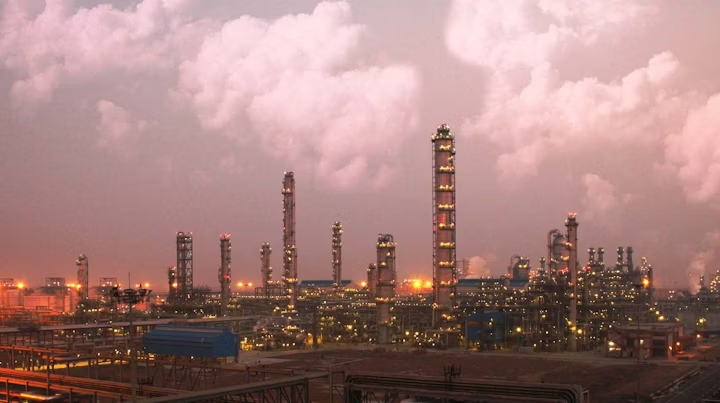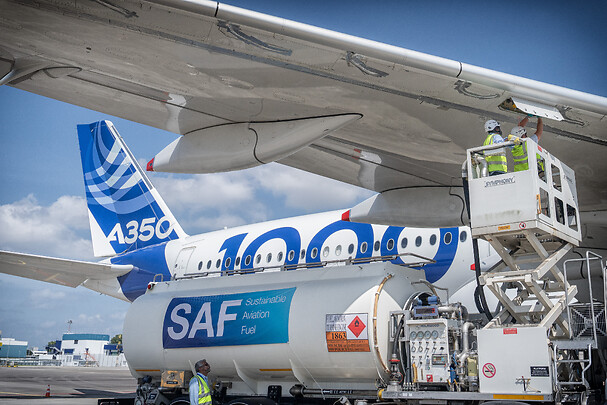Ameya Joshi

Early this month, Indian Oil’s Panipat refinery in Haryana announced that it will begin producing Sustainable Aviation Fuel (SAF) in December. This comes amidst the international certification received by the unit for manufacturing the biofuel from used cooking oil. By the end of this calendar year, IOC will have the capacity to produce 35,000 tonnes per year of SAF from used cooking oil, which will be sourced from large hotel chains, restaurants, and sweets and snacks majors, which normally discard cooking oil after single use.
The capacity of 35,000 tonnes per year will be sufficient to meet the country’s 1 percent SAF blending target for international flights by 2027. This comes as IOC becomes the first company in India to receive the ISCC CORSIA certification for SAF production, a prerequisite for commercial production of SAF. This will become a benchmark for the future when more refineries join in. India has seen a domestic flight operated with blended SAF, where AirAsia India operated from Pune to Delhi, with Pune-based Praj Industries being the supplier of SAF, while SpiceJet has operated its turboprop Q400 between Dehradun and Delhi with blended SAF.

From optics to commercial use
SAF is not popular for many reasons. The costs are prohibitive, with the fuel being three to four times costlier than ATF at the moment. This will come down over a period of time as more and more SAF is produced. Airbus, along with many other companies, is continuing to invest in SAF, a fuel that is much needed, albeit expensive, but certified to comprise up to 50% of the total fuel in an aircraft. In 2024, 75% of the 766 aircraft deliveries of Airbus used a SAF fuel blend. Airbus is heavily investing in SAF. Production at Airbus sites in Toulouse, Hamburg, Mobile, Tianjin, and Mirabel is using SAF for their internal operations. Airbus is offering SAF for delivery flights without any charges for its customers, even though SAF remains expensive.
SAF is fast becoming the first level towards decarbonisation goals and will likely provide a bulk of the emissions reductions needed by the aviation industry to reach the goal of net-zero carbon emissions by 2050, which IATA aims to achieve.
In recent years, Airbus has been increasing the percentage of SAF used in its own operations to 18%, which includes business travel, delivery flights (where a plane is delivered to the home base of the purchasing airline following the transfer of title), and transportation of aircraft parts between different production sites.

Toulouse is pretty much the centre of the SAF revolution, with TotalEnergies providing SAF for aircraft deliveries in Toulouse since 2016. Volotea, which operates a Hamburg-Toulouse flight for Airbus employees as part of our internal shuttle service, has been using a 34% SAF blend on this route since 2022. And following a successful pilot in 2023, since 2024, Air France-KLM and Airbus have had a “SAF fares agreement”, with Airbus purchasing SAF options for employee business travel connecting Paris with five locations: Hamburg, Madrid, Marseille, Munich, and Toulouse. Airbus launched a pilot scheme with easyJet, who operate flights on the Toulouse-Bristol route, a popular route for business travel due to the proximity to Airbus’ Toulouse and Filton sites. Running between November 2024 and January 2025, the scheme saw Airbus finance 106 tonnes of SAF, the equivalent amount of fuel necessary to run flights between Toulouse and Bristol on a 30% SAF blend during the period. Even though the quantity of SAF available has increased in recent years, demand remains suppressed due to the higher cost of SAF compared to kerosene, 2.8x according to the European Union Aviation Safety Agency’s (EASA) 2024 Aviation Fuels Reference Prices for ReFuelEU Aviation.
What are the challenges?
The challenges are multifold. The first is cost, the second is a lack of mandate for anyone, which makes it voluntary, and airlines and countries have different priorities, with near agreement that everyone will not be on the same page. This is set to change in India when the 1% blend is mandated starting 2027, for international flights out of India.
The other major challenge is the practicality of having SAF at airports. While it uses the same bowsers or hydrants and thanks, the transportation, mixing, safety and testing needs to have established protocols soon. Within days of IOC Panipat getting certified, Air India has already signed an MoU with IOC and more airlines are likely to follow the same path. There is no denying the fact that this is a good first step towards a greener tomorrow.
Ameya Joshi is an aviation analyst and columnist who runs the analysis website Network Thoughts.


